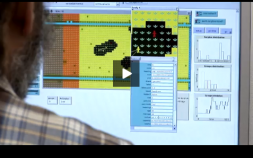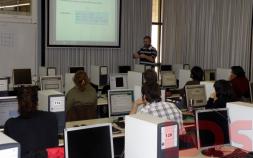Date: Mon, 5 Oct 2015 17:27:12 +0200
From: Nanda Wijermans <nwijermans@GMAIL.COM>
Subject: in search of role models - the final summary
Dear all,
Some time ago I posted the question “what ‘role' models do you have of social simulation models”? I was curious to hear what models you regard as exemplary or inspirational as a modeller.
I got quite some responses.
Brent Auble, Giacomo Cabri, Émile Chappin, Edmund Chattoe-Brown, Anders Christensson,
Helder Coelho, Corinne Coen, Simone Gabbriellini, Gianfranco Giulioni, Gert-Jan Hofstede,
Sylvie Huet, Luis Izquierdo, Thorben Jenssen, Peter Johnson and Norman Johnson.
Thanks a lot for for sharing your models and sometimes even emailing multiple times back and forth with me.
Below you may find the summary of all the responses I received (including the ones from the former summary). Enjoy a skim through!
Best wishes, Nanda
ps0. The models are ordered based on the moment I received it. When multiple references were made to the same model, I added another reason.
ps1. In case you feel like sharing more, feel free to do so to the list, this is the final summary I’ll be making.
------------------------------
--
SUMMARY ‘role' models
————————————————
1. A Monte Carlo Approach to Diffusion - Torsten Hägerstrand 1965 <https://journals.cambridge.org/action/displayAbstract?fromPage=online&aid=5456136>
Reason: Calibrated and validated "near" ABM in a mainstream social science journal in 1965! Do we routinely cite it as a standard we have to meet or beat? No.
2. Modelling the emergence and dynamics of social and workplace segregation - Mohamed Abdou & Nigel Gilbert 2009 <https://link.springer.com/article/10.1007/s11299-009-0056-3>
Reason: Table 3 on page 189. How often do you see real and simulated data compared in a published article? Rather rarely.
3. The Evolution of Ethnocentrism - Hammond & Axelrod 2006 <https://jcr.sagepub.com/content/50/6/926>
Reason: theoretical application - clarity in explaining how micro-dynamics create the macro phenomenon.
4. Modeling Interactions in Small Groups - Heise 2013 <https://spq.sagepub.com/content/76/1/52>
Reason: It is an agent-based model of a well-researched theory on social behaviour, Affect Control Theory, that reproduces turn taking patterns in US juries pretty amazingly. It does this without any reference to the content of what the people say – it thus shows that you can predict speech time based on affect.
5. The dissemination of culture - Axelrod 1979 <https://jcr.sagepub.com/content/41/2/203.short>
Reason: it's like for the Schelling's model: simple, clear and you might say common sense hypotheses that leads to unpredictable and counterintuitive outcomes. when you show that to students, it's like boom!
6. Leaving undesirable partners - Izquierdo,Izquierdo & Vega-Redondo 2014 <https://www.sciencedirect.com/science/article/pii/S0165188914001456>
Reason: the combined use of computer simulation and mathematical analysis (in particular, the mean field approximation). To our knowledge, this is the only model where you can run a (stochastic) agent-based model and its mean-field (deterministic) approximation side by side, for any parameter value.
7. EMLab-Generation / agentSpring - De Vries, Chappin & Richtstein 2013 <https://emlab.tudelft.nl/>
Reason: one of the first large ABMs, a model suite in which many different experiments can be done regarding energy and climate policy in Europe.
8. The TeamScript model - Coen 2006 <https://www.sciencedirect.com/science/article/pii/S0749597806000288>
Reason: An exemplar of identifying a decision rule from experimental data using an agent-based model.
9. Collective structure model - Johnson 2002 <https://see.library.utoronto.ca/SEED/Vol2-3/2-3%20resolved/Johnson.htm>
Reason: The help managers understand the different roles of innovation versus exploitation - and general concepts in complexity science.
10. Segregation Model — <https://www.jstor.org/stable/1823701>Schelling <https://www.amazon.com/Micromotives-Macrobehavior-Thomas-C-Schelling/dp/0393329461>1969
Reason: one of the easiest models to explain, useful for introducing the concept of agent-based models, and it produces unexpected results, which makes it very useful for discussing the concept of simple individual behaviors producing very different macro-scale behaviors.
Reason2: In 1969 and 1971, Schelling published a general theory of tipping, dealing with racial dynamics. This was the backbone for the attack to the segregation theme, and later on to the book “Micromotives and Macrobehavior”, a stone mark of the literature of agent-based computational economics. “The Strategy of Conflict”, which Schelling published in 1960, pioneered the study of bargaining and in what Schelling refers to as conflict behavior.
11. Sugarscape — Epstein & Axtell, 1996 <https://mitpress.mit.edu/books/growing-artificial-societies>
Reason: The careful construction of the model described in Growing Artificial Societies (Epstein & Axtell, 1996) is still one of the best examples of how to build a model from the ground up and how to carefully use social science theories for constructing model behavior.
Reason2: the first large scale agent model (in the book “Growing artificial Societies”) to simulate and explore the social phenomena such as seasonal migrations, pollution, sexual reproduction, combat, transmission of disease, and even culture.
12. Dynamic Social Impact Theory - Bibb Latané (1996) <https://www2.psych.ubc.ca/~schaller/528Readings/Latane1996.pdf>
Reason: can be seen as quite exemplary from many points of view, and especially regarding data and validation practices. Bibb Latané is a social psychologists and his theory was build from empirical data and has been validated afterwards with numerous laboratory experiments (numerous papers). This is a model of the dynamics of attitudes.
14. Conway's Game of Life - Gartner (1970) <https://www.scientificamerican.com/article/mathematical-games-1970-10/>
Reason: A small set of simple rules able to operate upon a 2-D checkers board.s
15. BOID - Reynolds -1987 <https://www.red3d.com/cwr/papers/1987/boids.html>
Reason: A first use of the virtual reality of lively biological systems (artificial life).
16. BioWar - Carley - 2004 <https://repository.cmu.edu/cgi/viewcontent.cgi?article=1854&context=isr>
Reason: A city-scale dynamic-network agent-based model for understanding the spread of disease and illness due to natural epidemics, chemical spills, and weaponized biological attacks.
17. Physical Model – Vinkovic&Kirman – 2006 <https://www.pnas.org/content/103/51/19261>
Reason: The physics of clustering is the analogue of the Schelling model. The economic concept of utility is replaced by the physics concept of a particle´s internal energy and as a result cluster dynamics is driven by the surface tension force.
———
Role models that were indicate with too little information for me to find a source and attach a link:
18. Eco - Doran - 2001
Reason: Ecology administration informed and motivated by consideration of the Fraser River watershed and its management problems.
19. ProtestLab - Lemos, Coelho & Lopes 2015.
Reason: To cover civil conflicts (protests) and violence with realism (greater explanatory power) is necessary to extend the Epstein´s formula with more mechanisms, such as legitimacy feedback, based upon the number of arrests, the media records of violent outbursts, and multi-context network influence effects with news, family, organizations and activist movements.
20. Epstein's formula - Epstein 2001
Reason: To capture collective behavior (civil violence, rebellion, revolution). Two categories of actors are considered, population and cops (key variables: grievance, legitimacy).




